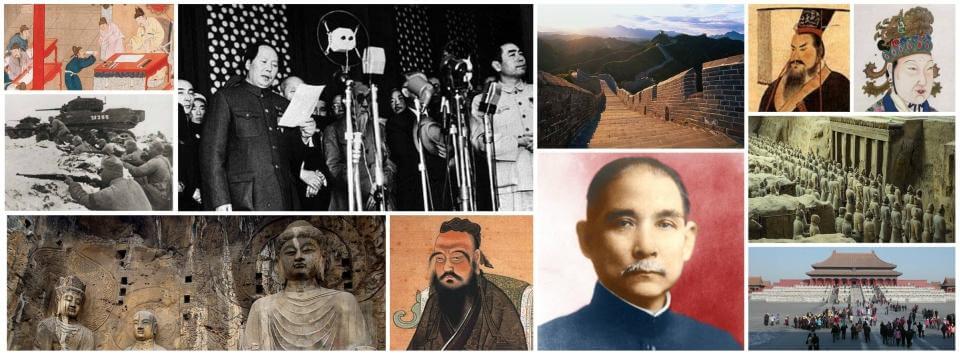
Shang Dynasty (ca. 1600 – 1046 BC)
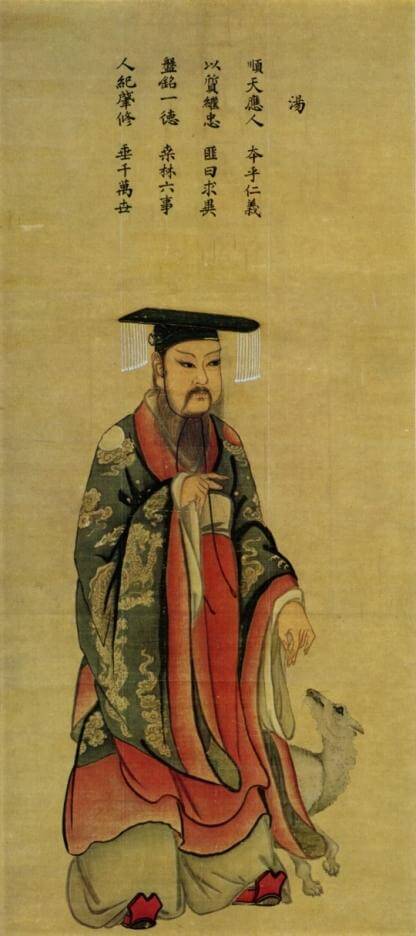 King Tang (Cheng Tang) of the Shang Dynasty as imagined by the Song Dynasty painter Ma LinThe Shang Dynasty (the earliest dynasty of which there are written records) was founded around 1600 BC (or precisely 1766 BC according to Chinese historians) when the tyrannic King Jie (the 17th King of the Xia) was overthrown by Cheng Tang, who became the first king of the Shang dynasty.
King Tang (Cheng Tang) of the Shang Dynasty as imagined by the Song Dynasty painter Ma LinThe Shang Dynasty (the earliest dynasty of which there are written records) was founded around 1600 BC (or precisely 1766 BC according to Chinese historians) when the tyrannic King Jie (the 17th King of the Xia) was overthrown by Cheng Tang, who became the first king of the Shang dynasty.
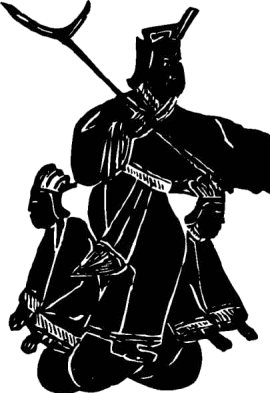 King Jie, last ruler of the Xia dynasty, sitting on two women and wearing a halberd on his shoulder. Rubbing of relief from the Wu-family Shrines, Jiaxiang, Shandong, around AD 150He was succeeded by a series of kings. What is interesting is that the monarchic power as the central institution in this political system
wasn't passed on from father to son at the beginning of this historical period. That was due to the low life expectancy of around 30 years at that time. Many rulers would have died before their offspring was old and experienced enough to assume leadership and control. Therefore, the kingship passed within a given generation from the older to the younger brothers. When the youngest of these brothers died, it would then move on to the eldest son of the eldest brother and so on.
King Jie, last ruler of the Xia dynasty, sitting on two women and wearing a halberd on his shoulder. Rubbing of relief from the Wu-family Shrines, Jiaxiang, Shandong, around AD 150He was succeeded by a series of kings. What is interesting is that the monarchic power as the central institution in this political system
wasn't passed on from father to son at the beginning of this historical period. That was due to the low life expectancy of around 30 years at that time. Many rulers would have died before their offspring was old and experienced enough to assume leadership and control. Therefore, the kingship passed within a given generation from the older to the younger brothers. When the youngest of these brothers died, it would then move on to the eldest son of the eldest brother and so on.
Cheng Tang established the Shang dynasty’s first capital at a town called Shang (within the area of modern-day Zhengzhou in Henan province). The town of Shang remained the ancestral capital throughout the dynasty where the most important ancestral temples were located and the most valuable tablets and regalia were kept. However, the political capital (where the kings were based) was moved repeatedly until it eventually remained based at the town of Yin (present day Anyang in the north of Henan province) for the last 200 years or so of the Shang dynasty's existence.
Most of our knowledge of the Shang comes from the discovery of oracle bones, since the original Shang documents that were written on silk and strips of bamboo didn't survive until the present era. Inscriptions on bronze objects were also found but they were generally very short, so that not much information could be learned from them. The oracle bone inscriptions represent the first appearance of a fully developed written Chinese script. There are no intermediate stages known on the path to a fully developed writing system. As soon as such a system appears, it is already fully developed. The staggering number of the discovered oracle bones (tens of thousands of them were excavated in pits near present-day Anyang in the north of Henan province) now constitute a kind of archeological record of the Shang dynasty.
Yin Ruins Museum (Yin Xu)
The Yin Ruins Museum is located in a park-like setting about 2km northwest of the city of Anyang (Henan province). This is the famous site of the ancient Shang dynasty capital Yin Xu where archeological digs have so far unearthed 150,000 oracle bones. The buried remnants of Yin Xu (which once covered a grand area of 24 square kilometers) constitute the biggest archaeological site in all of China.
Click here to learn more!Opening Hours
April - September: 8am - 6.30pm
October - March: 8am - 5.30pm
Entrance Ticket Prices
70 yuan
free for children under 1.2m
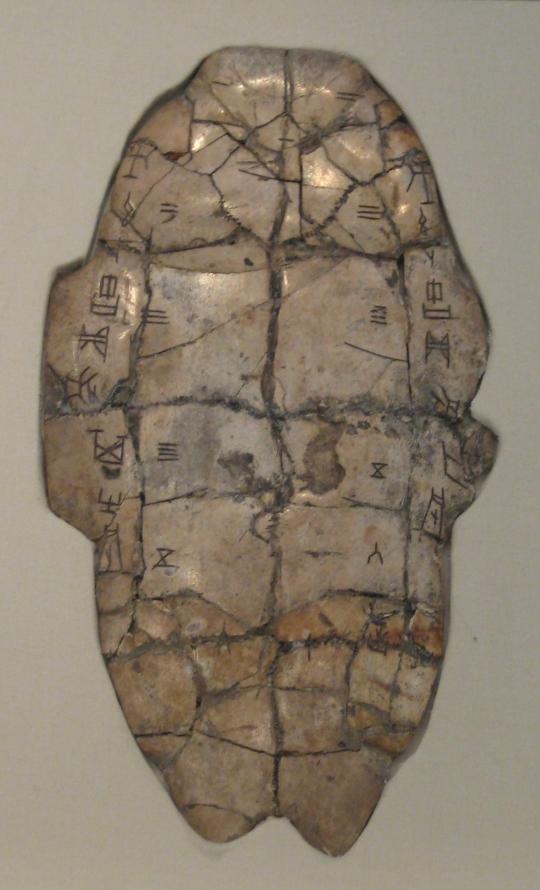 Tortoise plastron with divination inscription (Shang Dynasty, reign of King Wu Ding), National Museum of China, BeijingOracle bones were the shoulder bones of oxen or the underside shells of turtles (called plastrons). These bones were dried out until they were very brittle and then hot pokers (of bronze or thorn branches) were then pushed into small carved indentations on their surface. The direction of the resulting cracks was then interpreted as the voice of the ancestors.
Tortoise plastron with divination inscription (Shang Dynasty, reign of King Wu Ding), National Museum of China, BeijingOracle bones were the shoulder bones of oxen or the underside shells of turtles (called plastrons). These bones were dried out until they were very brittle and then hot pokers (of bronze or thorn branches) were then pushed into small carved indentations on their surface. The direction of the resulting cracks was then interpreted as the voice of the ancestors.
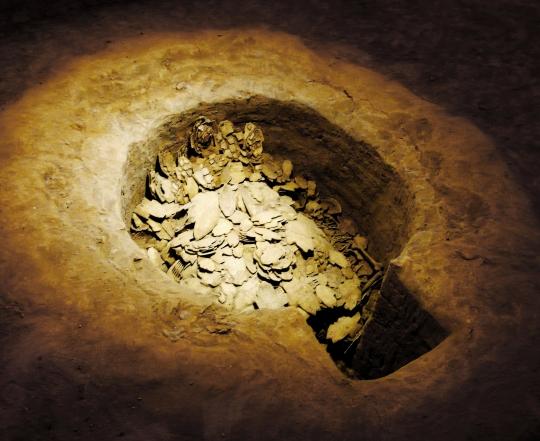 Pit of oracle bones found at the ruins of the last Shang dynasty capital near AnyangThe official diviners asked very specific ancestors very specific questions in a ritual setting, usually in the presence of the king and officials in the early mornings. These diviners could read and write and they marked the questions (for example: "Will there be a good harvest this year?"), answers ("Yes, there will be a good harvest.") as well as the actual occurring events ("But it wasn't a good harvest.") on the bones at a later time. They didn't just ask the questions once but over and over again to sort of find a predominant answer, which was assumed to be the true answer.
Pit of oracle bones found at the ruins of the last Shang dynasty capital near AnyangThe official diviners asked very specific ancestors very specific questions in a ritual setting, usually in the presence of the king and officials in the early mornings. These diviners could read and write and they marked the questions (for example: "Will there be a good harvest this year?"), answers ("Yes, there will be a good harvest.") as well as the actual occurring events ("But it wasn't a good harvest.") on the bones at a later time. They didn't just ask the questions once but over and over again to sort of find a predominant answer, which was assumed to be the true answer.
Some of these questions were banal and/or private in nature ("Will it rain tomorrow?") whereas others were of prime political importance ("When will be an auspicious time to go to war?"). This process of divination also served as a way of legitimization of the present rulers. Whereas rulers in other parts of the world kept their power through military feats, intrigues, access to riches etc., the Shang rulers kept their power because they were the only ones considered to have access to the knowledge of their ancestors through this process of divination.
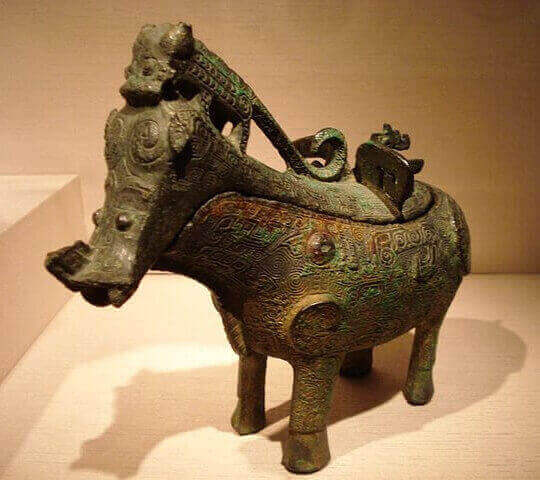 Bronze ritual wine container (zun) from the Shang Dynasty, dated 12th to 11th century BC. This creature was meant to be an elephant but the tusks broke offEven though the process of divination remained the predominant way in which the ancestors were worshipped, other ways emerged as well. Ritual bronze objects were produced for particular sacrificial ceremonies (for example: wine cups to offer liquid nourishment to the ancestors by pouring the wine on the ground, cooking vessels for cooking grains or meat that was then ritually offered to the ancestors) that were usually performed in large halls. After making these ritual sacrifices to the ghosts of the ancestors, who would consume the non-material essence of them, the remaining food and drink was then consumed in sumptuous feasts. In this way, the royal family displayed its affluence as well as influence (over the ancestors) and thereby legitimised its rule.
Bronze ritual wine container (zun) from the Shang Dynasty, dated 12th to 11th century BC. This creature was meant to be an elephant but the tusks broke offEven though the process of divination remained the predominant way in which the ancestors were worshipped, other ways emerged as well. Ritual bronze objects were produced for particular sacrificial ceremonies (for example: wine cups to offer liquid nourishment to the ancestors by pouring the wine on the ground, cooking vessels for cooking grains or meat that was then ritually offered to the ancestors) that were usually performed in large halls. After making these ritual sacrifices to the ghosts of the ancestors, who would consume the non-material essence of them, the remaining food and drink was then consumed in sumptuous feasts. In this way, the royal family displayed its affluence as well as influence (over the ancestors) and thereby legitimised its rule.
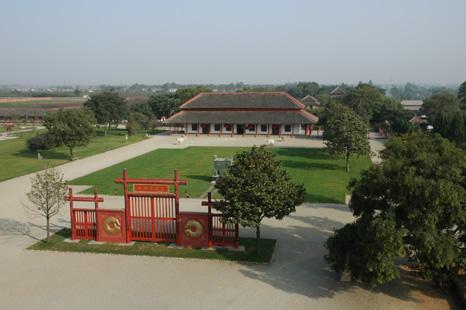 Entrance area of the Yin ruins museum in Anyang, HenanThe ruling family of the Shang and the people who were related to them by blood (or at least belonged to the same clan or tribal group) settled in the central area of the Shang empire (in the center of which was their capital) whereas other peoples settled in the periphery. Therefore, the Shang empire can be considered a federation of different peoples, all of which participated in the royal cult ceremonies and sent in written reports from their various territories. All communication from the king to his subordinate rulers was written down, so written communication about the regular operations of government was the basis of the Shang state and not only the oracle bone divination records.
Entrance area of the Yin ruins museum in Anyang, HenanThe ruling family of the Shang and the people who were related to them by blood (or at least belonged to the same clan or tribal group) settled in the central area of the Shang empire (in the center of which was their capital) whereas other peoples settled in the periphery. Therefore, the Shang empire can be considered a federation of different peoples, all of which participated in the royal cult ceremonies and sent in written reports from their various territories. All communication from the king to his subordinate rulers was written down, so written communication about the regular operations of government was the basis of the Shang state and not only the oracle bone divination records.
The writing system hints at a fairly sophisticated system of governance during the Shang dynasty. This sophistication can be clearly seen in the development of the Shang dynasty's metallurgical industry which is amply documented in divination records as well as other inscriptions. These beautiful and elaborately crafted ritual objects were produced in a multi-stage process. The mining and smelting (the blending of different metals to create bronze) took place outside the centers of Shang civilization and often far away from the workshops where large numbers of artisans crafted the moulds into which the molten bronze was then poured. The Shang government organized the large numbers of people who were involved in this production process fairly efficiently. That required managerial skill as well as an abundant capacity to feed and house people.
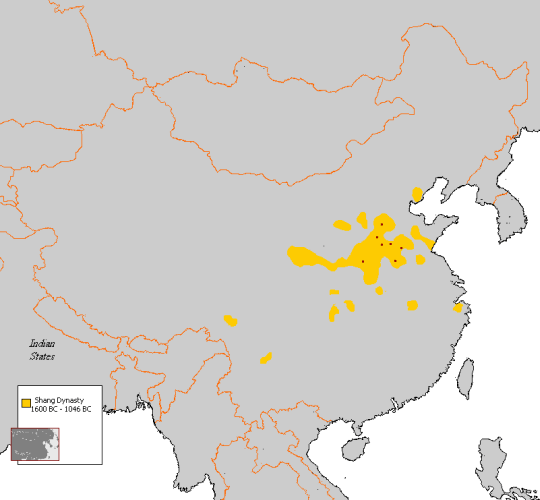 Location of the Shang dynasty stateThe monetary surplus to pay for all this was provided by a tributary system (or taxation system) that drew the necessary wealth in the form of tributes from subordinate peoples who lived in peripheral settlements to where it was needed to provide for the military as well as metallurgical industry. Both were important for the Shang dynasty to maintain its political legitimacy.
Location of the Shang dynasty stateThe monetary surplus to pay for all this was provided by a tributary system (or taxation system) that drew the necessary wealth in the form of tributes from subordinate peoples who lived in peripheral settlements to where it was needed to provide for the military as well as metallurgical industry. Both were important for the Shang dynasty to maintain its political legitimacy.
The Shang's military was sufficient for a long time to suppress unrest and enforce tributary payments among its peripheral people and fight off incursions from other unaffiliated tribes all around their territory. Conflict with these surrounding 'barbarians' was a constant concern though, that is evidenced by frequent inscriptions on oracle bones about military incursions, punitive raids etc. by and against these outsiders. The oracle bone records frequently mention raids into settled areas by these non-Chinese peoples that resulted in a loss of agricultural products that were destroyed or carried off and the enslavement of the people who lived in these unsafe areas. As those security problems became more and more severe due to the Shang's growing problems with the mobilization and deployment of its military, subordinate peoples began to question the necessity and legitimacy of making tributary payments to the Shang rulers. Tributary payments were also meant to guarantee peace and security for those people who lived on the periphery of the Shang empire.
At about the 11th century BC, the Shang became increasingly unable to provide this security, which led to unrest among its tributary people. Eventually, some of these people tried to overthrow the Shang and to establish their own dynasty (just like the Shang had replaced the Xia).
Chinese History Digest's summary of China's history continues with the story of the Zhou dynasty in the next section. It was the longest lasting of all of China's imperial dynasties.


